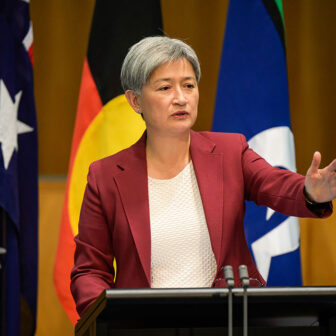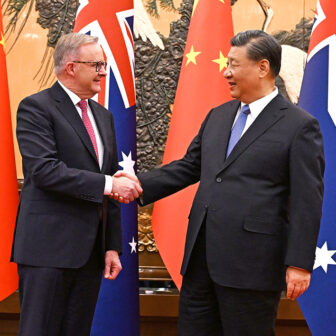IN JANUARY this year General Vo Nguyen Giap, the ninety-seven-year-old hero of the anti-French and anti-American wars, dispatched a letter to the Politburo in Hanoi arguing that a big Chinese bauxite mine project in Vietnam’s central highlands would significantly damage the environment, society and national defence. The Politburo had approved the project in 2007 without consulting the National Assembly.
Thanks to the internet, General Giap’s letter and two subsequent communications quickly reached a substantial audience both domestically and overseas. A petition against the bauxite mine was signed by over 2000 well-known intellectuals, academics and other concerned individuals; in a deliberate challenge to the police, each person appended his or her address. Remarkably, the Communist Party allowed a seminar on the bauxite mine project to be convened in April, at which scientists and economists voiced strong opposition.
Environmentalists presented evidence on the destructive impact of open-cut bauxite mining overseas. Social scientists pointed out how many ethnic minority inhabitants would be forced to relocate. But it was the thought of the 2000 Chinese employees of Chinalco who will work on the project, and likely Chinese intelligence operations in a sensitive region of the country, that made the mine an emotive national issue. Beyond that, some commentators warn that Vietnam has already become too dependent on Chinese imports and capital investment.
Not surprisingly, having faced four Chinese invasions since it gained independence from its giant neighbour in the tenth century, Vietnam is very sensitive to vibrations from the north. Despite the fact that periods of peaceful Sino-Vietnamese interaction far exceeded the times of war, each Vietnamese city and town contains streets named after generals who defeated Chinese armies. Traditionally Vietnam’s rulers, recognising the Chinese capital as the centre of their strategic universe, offered regular “tribute” payments to Beijing and sought endorsement of dynastic changes. So deeply was Vietnam influenced by classical Chinese civilisation that Vietnamese scholars sometimes scolded the Middle Kingdom court for not living up to the teachings of Confucius and Mencius.
During the early twentieth century, both Chinese and Vietnamese elites absorbed western concepts of nationalism, sovereignty and the equality of nation states. Nonetheless, huge disparities in population and land mass could hardly be ignored. Some Vietnamese endorsed French protection from China; some later welcomed US forces for much the same reason. Others still relied on China’s aid to defeat France, and then depended on Chinese and Soviet aid to defeat the United States. No sooner had Hanoi reunified Vietnam in 1975 than Beijing and Moscow bore down heavily on the Communist Party leadership to make a choice in the ongoing Sino–Soviet dispute. After Hanoi’s long-odds attempt to normalise relations with Washington collapsed, Vietnam sided with Moscow.
It was the beginning of a difficult time for Vietnam–China relations. In response to Khmer Rouge cross-border attacks, Vietnam invaded Cambodia in late 1978, and China invaded Vietnam soon afterward. The Red Army’s logistical chain proved inadequate to sustain its land offensive, so Deng Xiaoping declared that Hanoi had been taught a lesson and began withdrawing his forces. China’s attack was much less damaging than the economic blockade mounted against Vietnam by almost everyone except the Soviet bloc. Eventually the cost in lives and morale of sustaining Vietnam’s occupation of Cambodia, together with a precipitous decline in Soviet assistance, caused Hanoi to withdraw its last units from Cambodia in 1989. More than half of Vietnam’s overseas Chinese population had already fled or been deported.
Sino–Vietnamese relations improved substantially during the early 1990s. After the implosion of the Soviet Union there was a feeling among some Vietnamese communists that the future of Marxism–Leninism was in the hands of Beijing and Hanoi. Close ties could help both communist parties monopolise power.
But territorial disputes had yet to be resolved. From the mid 1950s, China had taken “temporary” control of a number of spots along the land frontier, and the return of control to the Vietnamese was repeatedly delayed in the name of operational efficiency. After the 1979 war, Chinese troops continued to occupy several hills on the Vietnamese side. Laborious negotiations in the 1990s appear to have resolved the land frontier, although some Vietnamese complain that too much was conceded to China.
Differences at sea were much more serious. In January 1974, the Chinese navy attacked and quickly defeated units of the US-supported Republic of Vietnam based on the Paracel Islands, 300 kilometres southeast of Hainan Island. Although Hanoi was deeply embarrassed by China’s occupation of the Paracels, it could not protest given its dependence on Beijing to defeat the South Vietnamese forces. Beijing then declared sovereignty over the entire continental shelf in the South China Sea, which brought it into prospective conflict not only with Vietnam but also with the Philippines, Malaysia and Brunei. In 1988, Chinese forces sank several Vietnamese naval vessels in the Spratly archipelago and occupied six islands.
OIL WAS THE CATALYST for the heightened focus on the Paracels and Spratlys. In the early 1970s, an American company had mapped promising drilling venues off the coast of southern Vietnam. After 1975, Vietnam invited in a Soviet oil company, which eventually brought several wells into production. During the 1990s, a number of western companies followed suit. Crude petroleum came to account for the largest proportion of Vietnam’s exports.
At first China chose only to challenge Vietnam-sponsored explorations in the Bay of Tonkin waters between Hainan Island and the north-central Vietnamese coast. Beijing and Hanoi agreed to draw a line halfway for purposes of awarding exploration contracts, but not for use as a territorial demarcation. More recently, however, China has started to challenge all Vietnamese oil-related operations on the continental shelf. Beijing’s most effective tactic is to warn foreign companies away from signing contracts with Vietnamese partners. In March of this year, BP withdrew from explorations only eighty kilometres off Vietnam’s south-central coastline. In July, Chinese envoys warned Exxon Mobil, the world’s largest oil firm, that its future mainland business could be jeopardised unless it pulled out of deals with Vietnam.
China also dispatched armed patrol vessels with orders to regulate all fishing in the South China Sea down to the twelfth degree latitude. In May, scores of Vietnamese fishing boats were stopped, crews detained, and vessels impounded. Vietnamese websites compared Chinese behaviour with that of the Somali pirates. Vietnam’s protests to Beijing had little effect, however, and Hanoi lacks sufficient patrol vessels to consider protecting fishermen within Vietnam’s 200 nautical mile offshore economic zone, much less beyond.
A huge number of cargo ships use the South China Sea to travel between the Straits of Malacca and East Asia. The United States, Japan and many other states regard the South China Sea as waters. In March, Chinese naval vessels harassed an American reconnaissance ship 125 kilometres off the coast of Hainan Island, causing Washington to protest the act as deliberate, dangerous and a violation of law. Beijing countered that the US ship had entered China’s offshore economic zone without permission and had conducted illegal activities.
In the past there have been calls for an or multilateral conference to deliberate the future of the South China Sea. If such a conference were to occur, Vietnam might abandon its claims to the Paracels in exchange for recognition of the portion of the Spratlys it currently occupies. China has opposed any isation of the issue, however, and shows no signs of budging from its continental shelf claims. For Hanoi to accept Chinese sovereignty over the continental shelf would mean having its entire coastline boxed in and losing all offshore oil rights.
On top of the controversy over the bauxite mine project in the central highlands, one issue beginning to receive attention in Vietnam is the impact of the hydroelectric dams being constructed by China on the upper reaches of the Mekong River. Last October, Chinese engineers in Yunnan finished building the Xiaowan dam – the world’s tallest, as high as the Eiffel Tower. When seven additional dams are completed, the total reservoir capacity will equal half the entire flow of the Mekong as it leaves China and moves downstream towards Laos, Thailand, Cambodia and Vietnam. A report from the UN Environment Programme warns that these dams are “the single greatest threat to the future of the river and its fecundity.” Cambodia’s Tonlé Sap lake will be the most affected, but the rhythms of cultivation and fishing in the lower Mekong as it flows through southern Vietnam will be disrupted as well. Beijing will also possess the option of altering flows to serve its own strategic purposes.
Last year, amid these developments, a Chinese website, sina.com, circulated details of a purported plan to attack Vietnam. Following five days of air and sea strikes, it projected, 310,000 Red Army troops would invade from three directions to seize Hanoi and beyond. Normally such an internet event would be dismissed as amateur gamesmanship, except in this case the ‘plan’ was reproduced on other Chinese sites and Beijing did nothing. The Vietnamese government, after twice summoning senior Chinese diplomats to complain, decided to go public to declare that such behaviour undermined bilateral relations.
Beijing’s push to great power status inevitably impacts on all of China’s neighbours. The all-weather roads constructed from China into Laos, for example, are already reducing dramatically Vientiane’s longstanding dependence on Thailand or Vietnam. China’s increased assertiveness in the South China Sea compels attention not only in Hanoi, Manila and Kuala Lumpur but also in Tokyo, Seoul and Taipei. So far, however, there are few signs of states on China’s periphery exchanging assessments, much less coordinating responses.
According to Duong Danh Dy, Vietnam’s former consul general in Canton, China’s leaders “never play only one card, never pursue only one scheme at a time, and they always have cards in reserve.” Dy adds that Vietnam’s leaders cannot suppose either that comradely relations of the 1950s and early 1960s can be revived, or that China’s internal problems will give Hanoi respite. Like a number of other current Vietnamese analysts, Dy hopes that the United States will play a more assertive role vis-à-vis China, but accepts that economic imperatives may prevent Washington from doing so. Meanwhile, China will continue to enhance its sea and air capabilities.
Until very recently it was impossible for Vietnam’s scholars or journalists to publish anything critical about contemporary China. In April, a newspaper was shut down for running articles on the offshore territorial dispute with China. The best that editors could do was run stories supporting the sailors based in the Spratlys, or extol yet another eighteenth-century document demonstrating Vietnamese contact with the islands. Now, however, the bauxite mine issue is being discussed extensively. The National Assembly has been debating consequences and considering alternatives. Government officials say the overall scale of the mine may be cut in half. On the other hand, Vietnamese are long familiar with the Party making tactical concessions in order to deflect criticism, then silencing the critics and proceeding as originally intended. One senior official let slip a little of the impatience he was feeling when he acknowledged the respect owed to General Giap as elderly national hero, but added immediately, “Now we are under the leadership of the present government and Communist Party.”
In private conversation, people label some Party leaders as “too close to China.” Others are said to be trying to enrol Washington as counterweight to Beijing. Even serving Vietnamese officials now talk to foreigners about the “China problem” in ways that would have been unthinkable a few years ago. Over the long haul, the intelligence services of both Vietnam and China have accumulated considerable knowledge about each other’s political elites, and presumably are now trying to exploit differences of interest, viewpoint and policy preference.
In Australia, a debate is under way about how to evaluate China, triggered by the Defence White Paper 2009. It seems to me that a false dichotomy has emerged, whereby China’s growing military capability is judged either a threat or a natural, legitimate consequence of rising economic power. Vietnam’s experience demonstrates that relations with China are not an all-or-nothing proposition; there are usually multiple influences and possibilities at work. In regard to the South China Sea, Vietnam will seek to induce a negotiated compromise, based on shared interests, while simultaneously preparing for the possibility that China will choose confrontation. Australia’s distance from China does not mean it will never be faced with similar circumstances. •




